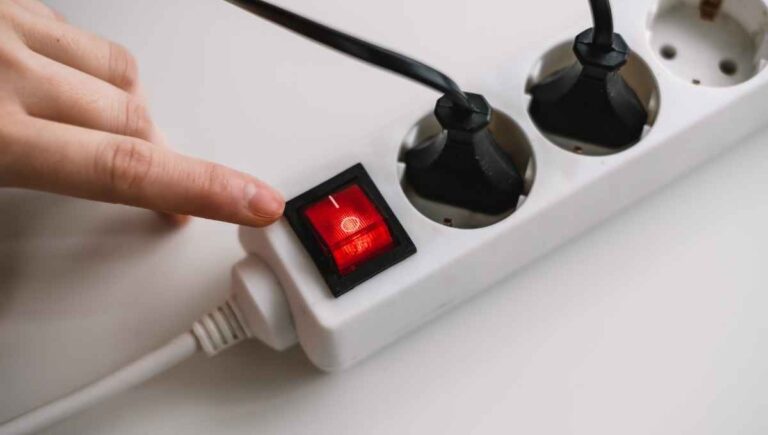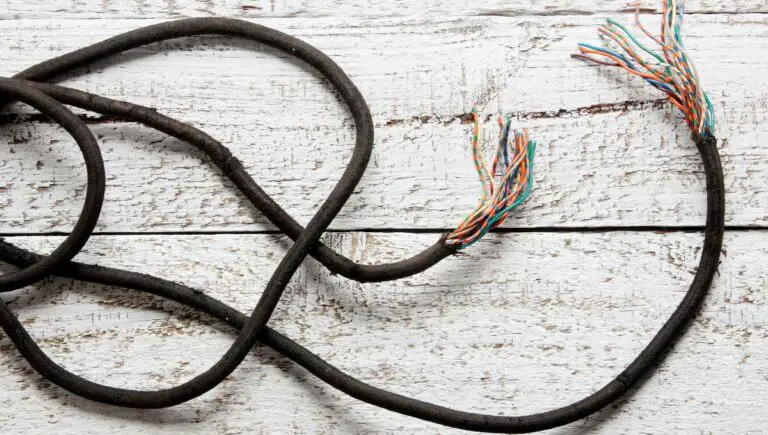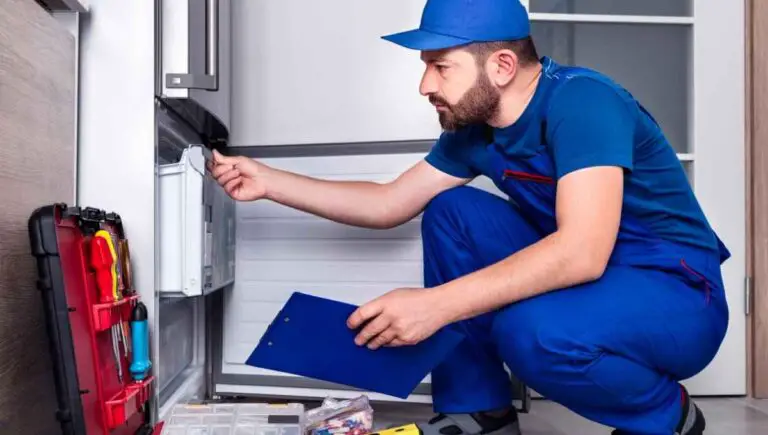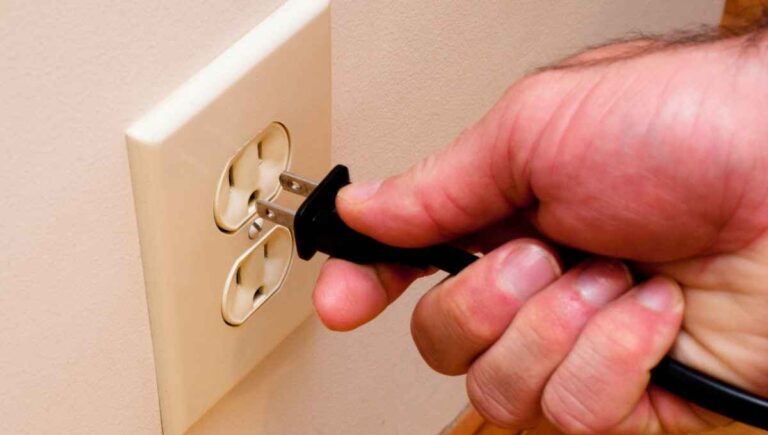Why Do Mini Fridges Get Hot? (Tips to Avoid Overheating)

Noticing your mini fridge getting hot can be concerning for you, especially if you live in a small space. The last thing you want to do is cause a fire just because you wanted a few extra beverages to stay cool. So, why do mini fridges get hot and what can you do to avoid overheating?
Mini fridges get hot because of the refrigeration process. As the compressor runs, it generates heat, which is usually dissipated through the back or sides of the fridge. This heat can cause the surface of the fridge to become warm to the touch.
However, it’s not always easy to tell how hot is too hot for a mini-fridge. That is just one of the topics we plan to cover in this article. So, if you’re worried about your hot mini fridge, you’ve come to the right place! Stay with us.
This post contains affiliate links. This means Household Blogger may earn a commission should you make a purchase using any of our links. Please refer to our full affiliate disclosure policy for full details.
Here’s a Quick Pro Tip!
Mini-fridges are a great way to store drinks and snacks without having to make the trek to the kitchen. Did you know, however, that there are several different mini-fridges?
Here are three of our favorite types of mini-fridges, one for every occasion!
1. Fridge/Freezer Model – Has a built-in freezer, perfect for your hot pockets!
2. On the Go Model – Perfect for camping, can use electricity or propane!
3. Beverage Cooler – Keep all your cold beverages at optimal drinking temperature!
Hot Mini Fridges
While it’s normal for a mini fridge to be warm to the touch, especially while the motor is cooling off the interior, it’s not normal to be hot enough to cause damage to the surrounding areas. Let’s talk about how hot is too hot.
Is It Normal for a Mini Fridge to Get Hot?
It is normal for the side of a mini fridge with the cooling unit to warm up while working. This is due to the flow of electricity. However, if your unit is too hot to touch, there may be a problem.
Optimally, you’ll leave at least an inch or two of space around all sides of your mini fridge. This allows for airflow around the machine, which helps to keep it cool. Additionally, if you notice that the unit is hot even when it’s not running, there may be a problem.
Is It Bad That My Mini Fridge Is Hot?
If the outside of your mini fridge is hot to the touch, it’s not necessarily bad. However, if the fridge is currently running a cooling cycle, it can cause the compressor to heat up while delivering cold air.
If the mini-fridge is hot to the touch and hasn’t been running, or if the inside is warm, you may have a bigger problem. Start by checking the internal temperature of the mini fridge and turning it down if necessary.
How Do I Stop My Mini Fridge From Overheating?
Ensure your mini fridge has adequate ventilation and is placed away from all walls. One of the most common reasons mini-fridges overheat is that they are placed too close to walls, and the compressor doesn’t have adequate ventilation.
How Hot Should a Mini Fridge Get?
A mini-fridge can get pretty hot, but it shouldn’t burn you or damage the walls around it due to heat. Most mini-fridges also have a built-in defroster, which uses warm air to prevent frost and ice build-up. This can make the walls of the mini-fridge feel hot.
Your mini-fridge should never get hot enough to scorch your walls, and the inside should never exceed 40 degrees Fahrenheit. If you notice that your fridge is running warmer than 40F, you may need to have someone check it out, as improperly cooled foods can harbor bacteria.
Do Mini-Fridges Heat up a Room?
Mini-fridges do not generate enough heat to heat a room significantly. If your minifridge is a significant factor in the temperature of your room, you should unplug it until you can have someone look at it. It may be overheating and could spark.
However, the warm air released from the cooling unit may flow from the mini-fridge, making the room feel a degree or two warmer while it’s running. It shouldn’t get much warmer than that, however.
Internal Mini Fridge Concerns
If your mini fridge seems hot, you probably think it’s just the coils heating, nothing to be concerned about. But what about what’s going on inside? We’re discussing those important internal factors right now!
Is It Normal for a Mini Fridge Compressor to Be Hot?
Part of a compressor’s job is allowing the defroster to warm up to prevent ice crystals. This can lead to the compressor being warm or even hot to the touch. However, it’s nothing to be concerned about.
However, if your mini-fridge stays consistently hot, there may be a problem. One of the most common issues is that your compressor is running low on refrigerator coolant. Add some more in, and the heating problem should cool itself off.
Does the Compressor on a Mini Fridge Get Hot?
The compressor on a mini fridge warms up to defrost the unit. It’s a normal part of a mini-fridge cycle and should not be a cause for concern unless you smell burning or smoke.
If your unit starts smoking, it may be time to replace the compressor. The compressor for a mini-fridge is relatively easy to change out, but if you’re not comfortable working with wiring, you may want to contact a professional.
Can a Mini Fridge Overheat?
If the compressor goes bad, a mini-fridge can overheat. If you notice signs of burning, the smell of melting plastic, or smoke coming from the unit, immediately unplug it.
The compressor can typically be fixed or replaced if you catch the problem early enough. Otherwise, you may be in the market for a new mini-fridge. Fortunately, most situations are fixable.
Can You Plug a Mini Fridge Into a Regular Outlet?
A mini fridge should be fine plugged into a regular, grounded outlet. Grounded outlets help prevent power surges, which may overload your mini-fridge. They are standard in a house or apartment, especially in the kitchen.
It’s easy to tell if your outlets are grounded or not. Grounded outlets have space for three-pronged plugs, and you cannot plug in certain devices unless you have grounded outlets for safety reasons.
How Long Can a Mini Fridge Last?
A mini fridge will typically last for ten years if properly taken care of. As with all other appliances, the better care you take, the longer it is likely to work properly and with minimal issues.
Of course, the quality of the mini-fridge will also play a role in how long it lasts. Cheaper, poorly made mini-fridges typically only last five years or so, but high-end models can last for up to 15 years.
Keeping a Mini Fridge Cold
One of the main concerns of those who have never used a mini-fridge is how do they stay cold? Well, in this section, we’ll reveal all the secrets to keeping your mini-fridge between 33 and 40 degrees Fahrenheit!
How Do I Keep My Mini Fridge Cold?
Your mini fridge should keep itself between 33 and 40 degrees with no input from you. However, if you notice it’s freezing or not getting cold enough, you may need to adjust the thermostat.
If adjusting the thermostat isn’t giving you the results you need, the thermostat may need to be replaced. You can purchase just a new thermostat, which will then need to be rewired into the compressor. You can do this yourself or contact a professional.
Should a Mini Fridge Run All the Time?
Unlike full-size refrigerators, mini-fridges need to run 24/7 in order to keep their contents at an appropriate temperature. This is one of the reasons mini-fridges seem warmer than full-size fridges.
A mini-fridge needs to run all the time, so you must keep proper ventilation surrounding it. Without proper ventilation, the unit could overheat, which will not only break the mini-fridge but may cause damage to your home.
Why Is My Mini Fridge Not Cold?
If you’ve just plugged in your mini-fridge, it will take a few hours to come down to a temperature suitable for food storage. However, the compressor may go bad if your mini-fridge has been cold but is now warm.
However, other common issues may prevent your mini fridge from cooling down, including:
- The evaporator fan motor is broken.
- The condenser fan motor is dead.
- Issues surrounding the evaporator coils.
- Control board failure.
- The filter is clogged.
- The thermostat is broken.
Why Is Only One Side of My Mini Fridge Hot?
Your mini-fridge will be warmer on the side that houses the compressor coils and defrost unit. These units get warm due to having to defrost the mini-fridge and from constant running and cooling of the interior.
If possible, keep that side of the mini-fridge as far from a wall or other obstructions as possible. The more airflow the side of the mini-fridge can get, the less likely it is that the system will overheat or have problems due to temperature.
Should My Mini Fridge Be Too Hot to Touch on the Outside?
While it is normal for the outside of a mini-fridge to be warm or even hot, if it’s too hot to touch or burns you when you accidentally come in contact with the outside, something may be overheating.
If your mini-fridge is overheating, you may need to replace either the compressor or the fans. Either of these can cause significant overheating if they have gone bad, and without them, your fridge can’t properly keep food cold.
You might also enjoy our post on Can You Put a Refrigerator on its Side?
Settings on a Mini Fridge
If you’re concerned about the temperature of your mini-fridge, one of the quickest and easiest solutions is to change the thermometer settings. But typically, they aren’t well labeled, and who wants to pull out the owner’s manual just for that? Don’t worry. We’ve got your back, and we’re talking about setting right now!
Is One or Seven Colder in a Mini Fridge?
For most mini-fridges, the lower the number, the colder the setting. So having a fridge at zero or one will keep it closer to 32 degrees, whereas seven would keep it closer to 40 degrees.
However, each mini-fridge has its own settings, so if you’re unsure, it’s always best to double-check the manufacturer’s manual. That way, you don’t have to worry that your mini-fridge isn’t working properly.
What Is the Best Setting for a Mini Fridge?
Each mini-fridge will run slightly differently. The best setting you can have for your fridge keeps it between 33 and 38 degrees Fahrenheit, the optimal temperature for cold food storage.
You want your cold food to stay in that temperature range because it does not allow bacteria to grow, therefor your food stays fresh longer. While all mini-fridges will have cycles that are a little warmer and a little cooler, they should stay in the safe range to prevent foodborne illness.
How Can I Cool Down My Mini Fridge Faster?
To keep your mini-fridge as cool as possible, make sure it’s in a cool room. You should also keep it away from walls or anything that prevents the unit from being properly ventilated.
Some other ways to keep your mini-fridge cool are:
- Defrosting the unit regularly.
- Make sure your food has cooled to room temperature before placing it in the mini-fridge.
- Remove other heat-producing appliances from close to the unit.
- Ensure the door gaskets are sealing properly.
- Only use a mini-fridge on a clean, hardwood floor. No carpets!
Should You Put a Mini Fridge on Carpet?
If you’re worried about the cooling performance of your mini-fridge, keep it off a carpeted floor. Carpet helps trap warm air and can cause overheating issues. It can also block airflow and ventilation.
All of these factors can prevent the mini-fridge from being able to cool itself properly. This can lead to your mini-fridge overheating, which can cause issues with your outlets and the unit itself.
You might also enjoy our post on Can You Put a Refrigerator on Carpet?
Related Questions
Is It Bad to Have a Mini Fridge in Your Room?
There is nothing wrong with keeping a mini-fridge in your room. If you are a college student, having a small cooling unit in your room is handy for keeping drinks and snacks cold.
Even if you’re not a college student, having a mini-fridge in your room can be handy. However, you may notice that the fridge makes the occasional loud noise as it cycles. As long as you’re a heavy sleeper, this shouldn’t affect you too badly.
Where Should You Not Put a Mini Fridge?
You can put your new mini-fridge anywhere you would like. However, it is recommended that you do not place a mini-fridge on the carpet. Placing your mini-fridge on a carpeted floor prevents it from properly ventilating air.
When mini-fridges are placed on the carpet, the carpet can help trap warm air, which in turn heats the mini-fridge. Instead, you should place your mini-fridge on hard, flat flooring to get proper airflow.
Do Mini-Fridges Use a Lot of Electricity?
Mini-fridges do not use much electricity compared to other large appliances. That said, they run nearly constantly and can use up to 65 watts while running, so they are heavy energy consumers.
However, full-size refrigerators typically use at least 200 watts a day, so it doesn’t seem so bad when you compare that to your mini-fridge consuming 65 watts. You can keep down energy consumption by ensuring your fridge is closed properly and has the necessary ventilation.
Final Thoughts
Mini-fridges are certainly convenient for many. While they can get hot along the outside, it’s typically not a big deal. However, if you notice the smell of melted plastic or burning, check it out and make sure your mini-fridge isn’t overloaded!











